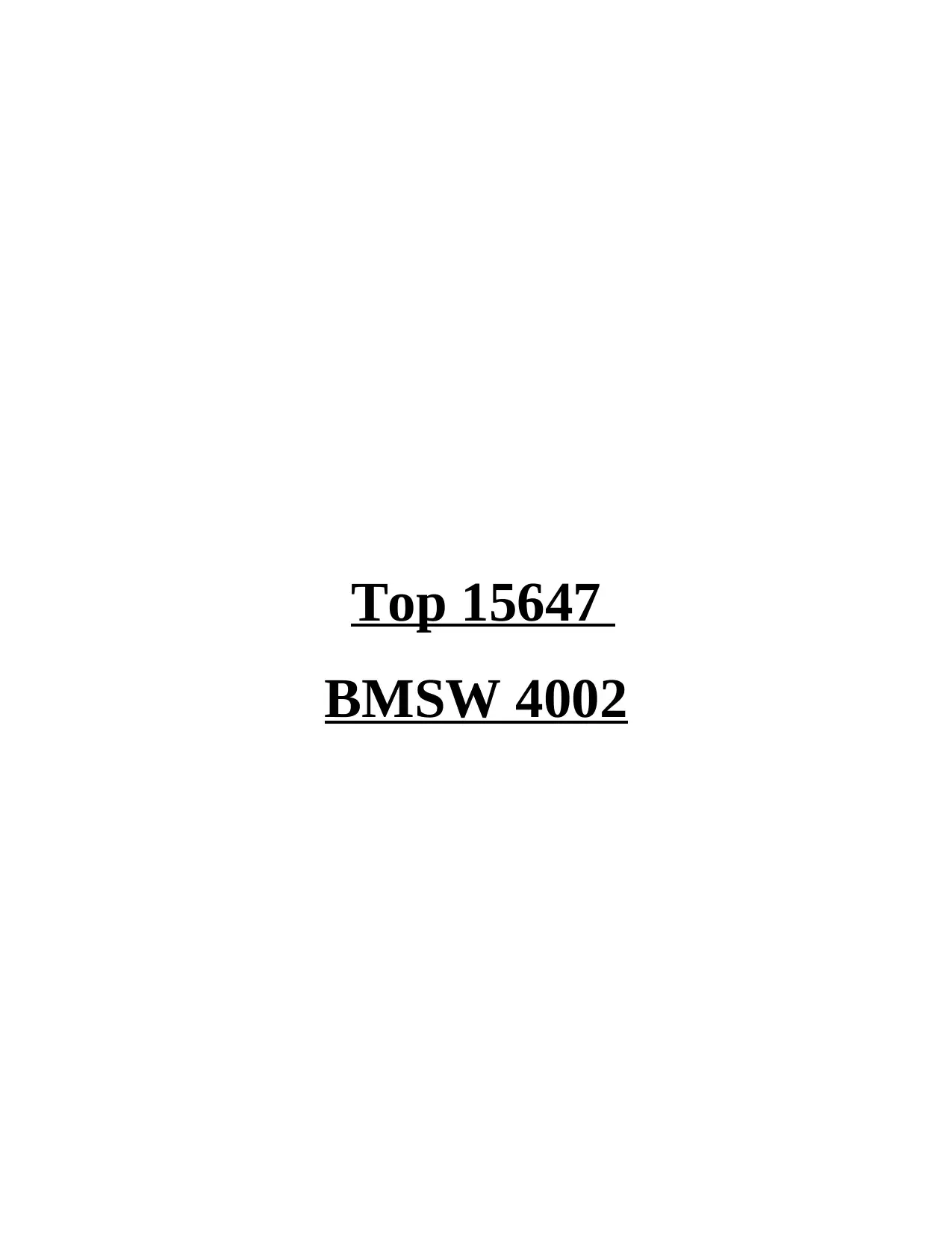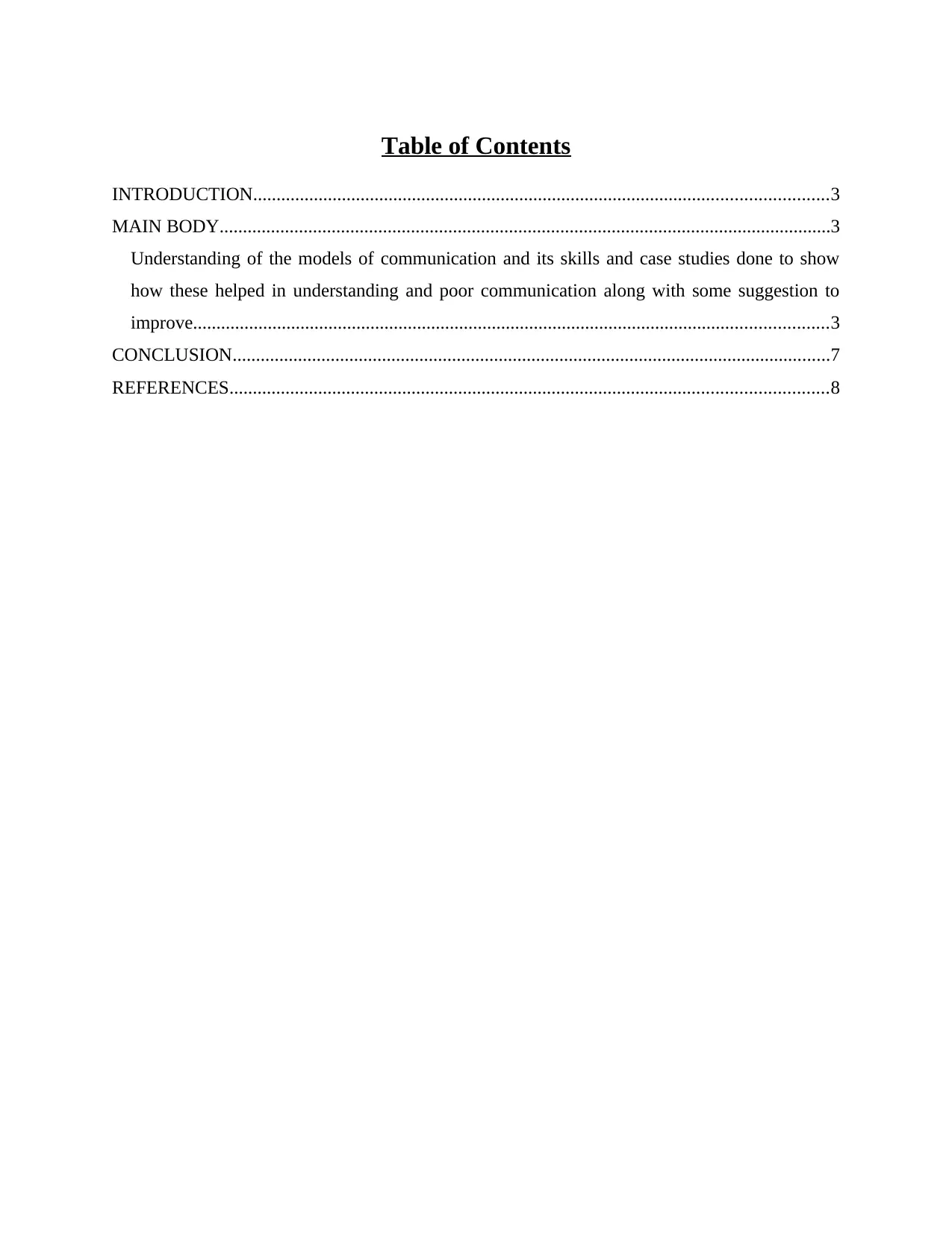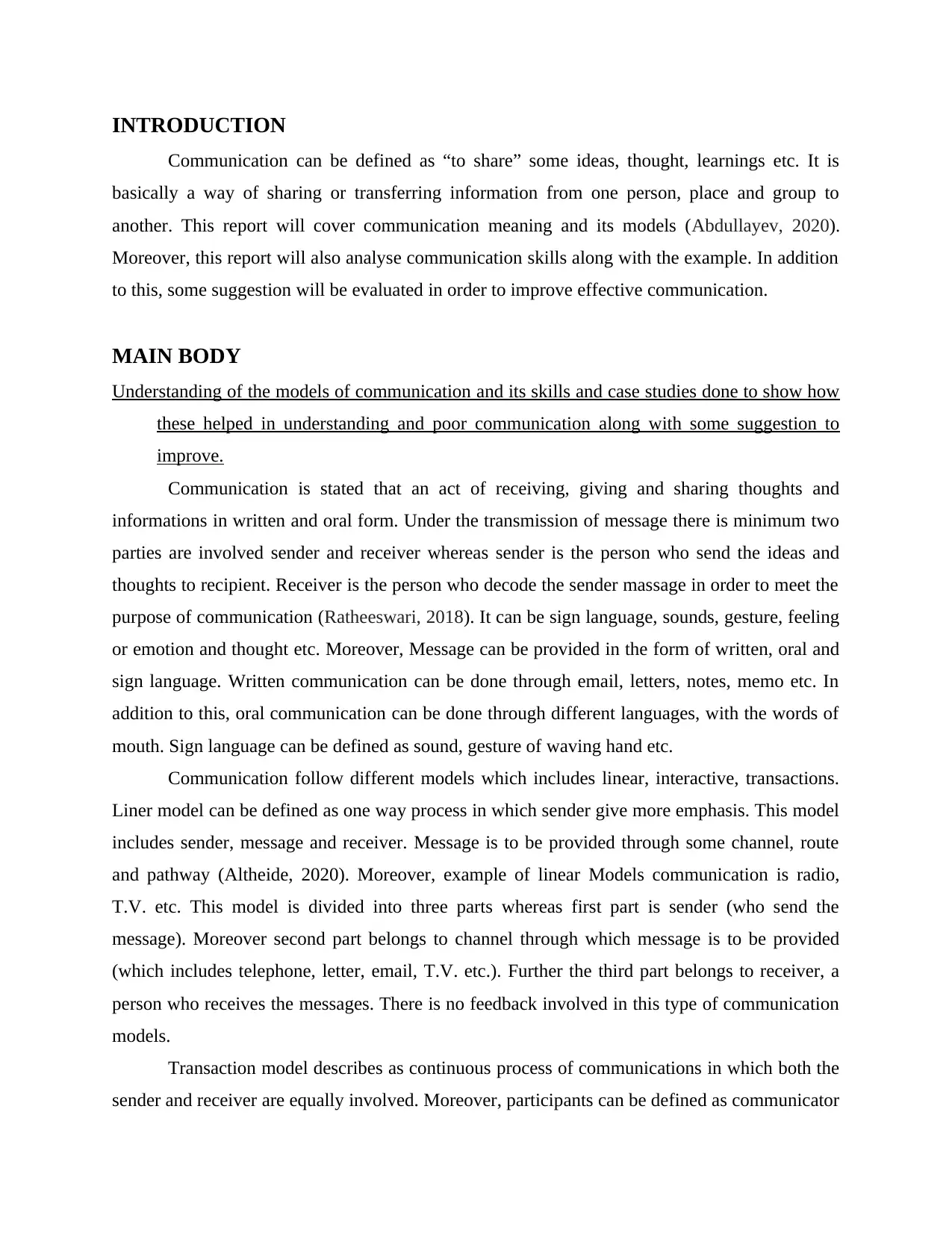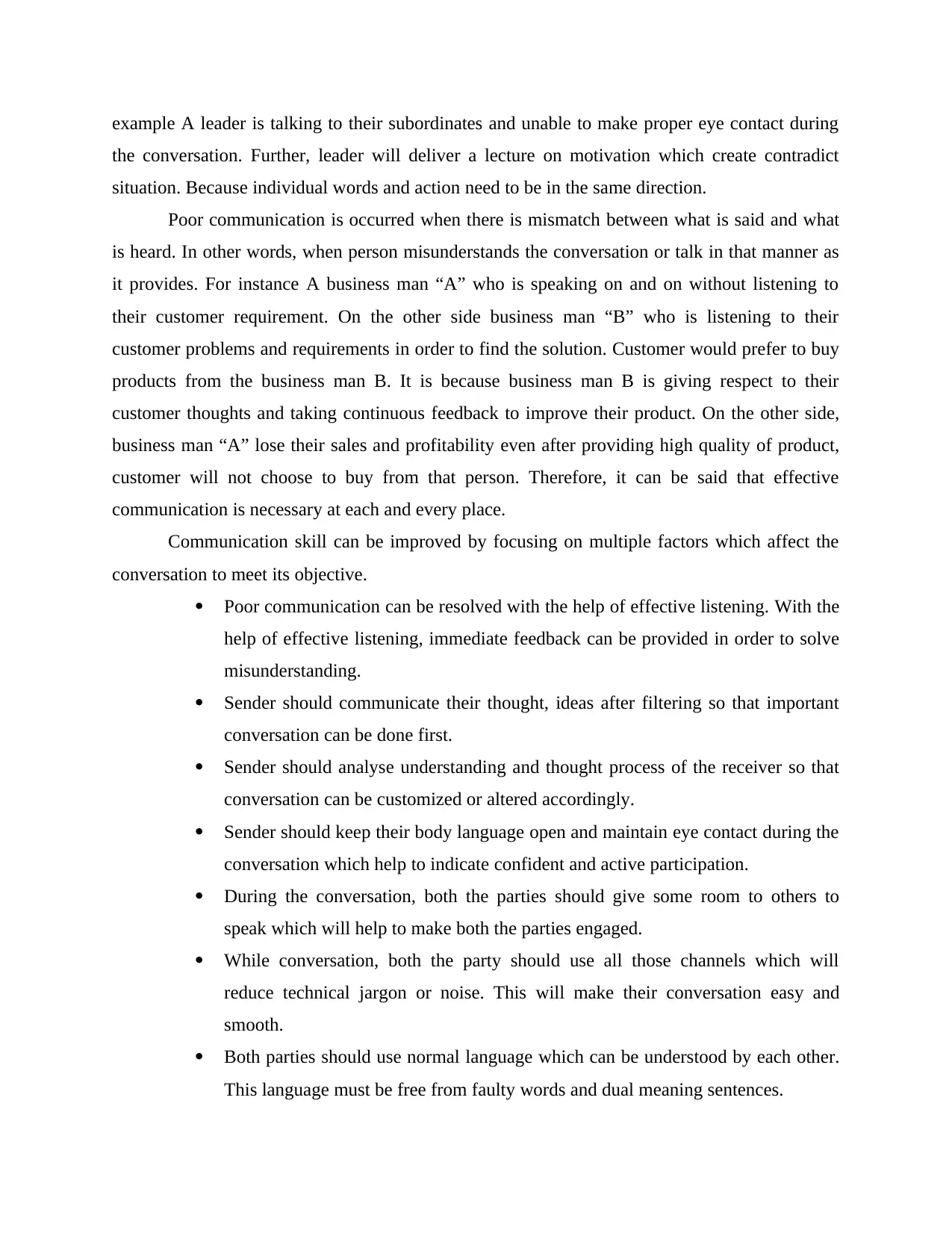BMSW 4002 - Communication Models, Skills, and Improvement Strategies
VerifiedAdded on 2023/06/18
|9
|2573
|240
Report
AI Summary
This report provides an overview of communication, its models (linear, interactive, transactional), and essential skills. It emphasizes the importance of verbal and non-verbal communication, active listening, and clarity. The report analyzes how effective communication builds trust and highlights instances of poor communication stemming from misunderstandings or lack of engagement. It also offers strategies for improving communication skills, such as active listening, clear messaging, understanding the receiver's perspective, maintaining open body language, and utilizing appropriate communication channels. Case study examples are used to illustrate these points. It concludes that mastering communication is crucial for personal and professional success, and highlights the ways organizations can meet their objectives with effective communication.

Top 15647
BMSW 4002
BMSW 4002
Paraphrase This Document
Need a fresh take? Get an instant paraphrase of this document with our AI Paraphraser

Table of Contents
INTRODUCTION...........................................................................................................................3
MAIN BODY...................................................................................................................................3
Understanding of the models of communication and its skills and case studies done to show
how these helped in understanding and poor communication along with some suggestion to
improve........................................................................................................................................3
CONCLUSION................................................................................................................................7
REFERENCES................................................................................................................................8
INTRODUCTION...........................................................................................................................3
MAIN BODY...................................................................................................................................3
Understanding of the models of communication and its skills and case studies done to show
how these helped in understanding and poor communication along with some suggestion to
improve........................................................................................................................................3
CONCLUSION................................................................................................................................7
REFERENCES................................................................................................................................8

INTRODUCTION
Communication can be defined as “to share” some ideas, thought, learnings etc. It is
basically a way of sharing or transferring information from one person, place and group to
another. This report will cover communication meaning and its models (Abdullayev, 2020).
Moreover, this report will also analyse communication skills along with the example. In addition
to this, some suggestion will be evaluated in order to improve effective communication.
MAIN BODY
Understanding of the models of communication and its skills and case studies done to show how
these helped in understanding and poor communication along with some suggestion to
improve.
Communication is stated that an act of receiving, giving and sharing thoughts and
informations in written and oral form. Under the transmission of message there is minimum two
parties are involved sender and receiver whereas sender is the person who send the ideas and
thoughts to recipient. Receiver is the person who decode the sender massage in order to meet the
purpose of communication (Ratheeswari, 2018). It can be sign language, sounds, gesture, feeling
or emotion and thought etc. Moreover, Message can be provided in the form of written, oral and
sign language. Written communication can be done through email, letters, notes, memo etc. In
addition to this, oral communication can be done through different languages, with the words of
mouth. Sign language can be defined as sound, gesture of waving hand etc.
Communication follow different models which includes linear, interactive, transactions.
Liner model can be defined as one way process in which sender give more emphasis. This model
includes sender, message and receiver. Message is to be provided through some channel, route
and pathway (Altheide, 2020). Moreover, example of linear Models communication is radio,
T.V. etc. This model is divided into three parts whereas first part is sender (who send the
message). Moreover second part belongs to channel through which message is to be provided
(which includes telephone, letter, email, T.V. etc.). Further the third part belongs to receiver, a
person who receives the messages. There is no feedback involved in this type of communication
models.
Transaction model describes as continuous process of communications in which both the
sender and receiver are equally involved. Moreover, participants can be defined as communicator
Communication can be defined as “to share” some ideas, thought, learnings etc. It is
basically a way of sharing or transferring information from one person, place and group to
another. This report will cover communication meaning and its models (Abdullayev, 2020).
Moreover, this report will also analyse communication skills along with the example. In addition
to this, some suggestion will be evaluated in order to improve effective communication.
MAIN BODY
Understanding of the models of communication and its skills and case studies done to show how
these helped in understanding and poor communication along with some suggestion to
improve.
Communication is stated that an act of receiving, giving and sharing thoughts and
informations in written and oral form. Under the transmission of message there is minimum two
parties are involved sender and receiver whereas sender is the person who send the ideas and
thoughts to recipient. Receiver is the person who decode the sender massage in order to meet the
purpose of communication (Ratheeswari, 2018). It can be sign language, sounds, gesture, feeling
or emotion and thought etc. Moreover, Message can be provided in the form of written, oral and
sign language. Written communication can be done through email, letters, notes, memo etc. In
addition to this, oral communication can be done through different languages, with the words of
mouth. Sign language can be defined as sound, gesture of waving hand etc.
Communication follow different models which includes linear, interactive, transactions.
Liner model can be defined as one way process in which sender give more emphasis. This model
includes sender, message and receiver. Message is to be provided through some channel, route
and pathway (Altheide, 2020). Moreover, example of linear Models communication is radio,
T.V. etc. This model is divided into three parts whereas first part is sender (who send the
message). Moreover second part belongs to channel through which message is to be provided
(which includes telephone, letter, email, T.V. etc.). Further the third part belongs to receiver, a
person who receives the messages. There is no feedback involved in this type of communication
models.
Transaction model describes as continuous process of communications in which both the
sender and receiver are equally involved. Moreover, participants can be defined as communicator
⊘ This is a preview!⊘
Do you want full access?
Subscribe today to unlock all pages.

Trusted by 1+ million students worldwide

who can be either machine or human beings. Here in this process sending the message take place
at the same time that is way it describes the communication as a circular mode of communication
(Guzman and Lewis, 2020). Transactional model is the two-way process where both the parties
are fully involved in communication process. Some factors such as social, relational and cultural
context which affect the transnational model of communication. Moreover, this models often use
interpersonal communication where both sender or receiver of the message take active part in
order to keep communication open. That is the reason, it does not occur in that case where
message are not to be heard due to technical jargon.
Interactive model of communication in which both the parties are taking equally interest
to encode or decode of message. One of the most important feature involved in this is feedback
loop. This will result in new understanding of encode or decode of verbal and non-verbal
message. Moreover, it put more emphasis on overall communication in order to make the
interactive conversation. In this model sender sent the ideas and thoughts after that receiver
decode the message and provide the feedback.
An effective communication is required in the life to make every thing easily.
Communication is to be divided into two types verbal and non-verbal. Verbal communication is
done through words or languages like oral and written. Further, oral communication is done
through mouth words and languages (Ghasempour and et.al., 2017). Moreover, written
communication can be done through letters, notice and memo etc. Under the non-verbal,
communication occurred with the help of sign language like gesture, sound, images, posters etc.
Moreover, communication skill include active listening, adopting conversation style,
friendliness, confidence, respect and clarity etc. Moreover, active listening means paying full
attention to the person who is speaking. For example A person is speaking on and on and doesn't
want to listen other's thought which create a jargon in the conversation. A effective
communicator keep their arm open and make proper eye contact during the conversation.
Moreover, communication can be taken place in an organization through formal and informal
way. In the formal communication, speaker follow some rules, path or chain in order to send
their message. Further, under the informal communication, sender can sent their message without
following any processure (Camaioni, 2017). Facial expression also plays major role while
communicating with others. It is because a human face can produce thousands expressions which
have been decoded by the receiver in order to solve the purpose of communication. For example
at the same time that is way it describes the communication as a circular mode of communication
(Guzman and Lewis, 2020). Transactional model is the two-way process where both the parties
are fully involved in communication process. Some factors such as social, relational and cultural
context which affect the transnational model of communication. Moreover, this models often use
interpersonal communication where both sender or receiver of the message take active part in
order to keep communication open. That is the reason, it does not occur in that case where
message are not to be heard due to technical jargon.
Interactive model of communication in which both the parties are taking equally interest
to encode or decode of message. One of the most important feature involved in this is feedback
loop. This will result in new understanding of encode or decode of verbal and non-verbal
message. Moreover, it put more emphasis on overall communication in order to make the
interactive conversation. In this model sender sent the ideas and thoughts after that receiver
decode the message and provide the feedback.
An effective communication is required in the life to make every thing easily.
Communication is to be divided into two types verbal and non-verbal. Verbal communication is
done through words or languages like oral and written. Further, oral communication is done
through mouth words and languages (Ghasempour and et.al., 2017). Moreover, written
communication can be done through letters, notice and memo etc. Under the non-verbal,
communication occurred with the help of sign language like gesture, sound, images, posters etc.
Moreover, communication skill include active listening, adopting conversation style,
friendliness, confidence, respect and clarity etc. Moreover, active listening means paying full
attention to the person who is speaking. For example A person is speaking on and on and doesn't
want to listen other's thought which create a jargon in the conversation. A effective
communicator keep their arm open and make proper eye contact during the conversation.
Moreover, communication can be taken place in an organization through formal and informal
way. In the formal communication, speaker follow some rules, path or chain in order to send
their message. Further, under the informal communication, sender can sent their message without
following any processure (Camaioni, 2017). Facial expression also plays major role while
communicating with others. It is because a human face can produce thousands expressions which
have been decoded by the receiver in order to solve the purpose of communication. For example
Paraphrase This Document
Need a fresh take? Get an instant paraphrase of this document with our AI Paraphraser

A person is looking away to the receiver which is showing lack of confidence. A body posture
also play vital role to make conversation interesting. A lean posture (front side) shows respect
and involvement in the communication whereas back side lean posture shows the not interested
in the conversation. For example: leader while talking to their employees keep their body lean
toward the front side which is showing that leader respect their employees thought and their
ideas. A good communicator use hand movement while taking to other person which represent
friendly, involvement and confident. Straight forward talking is the another communication skill.
In which conversation is done on the basis of receiver interest and involvement. Moreover,
communication skill also includes quick problem solving, strong decision-making, strong
business relation, consistency in work etc.
Use a right language by analysing receiver understanding and thought process (Ruscher,
2017). If communicator use different language which is not understandable by receiver than the
purpose of communication will not get solved. Another skill of communication is clarity of
language and thought like if sender is confused what it is required to say then receiver will not be
in position to understand the same message in the same way as sender want to deliver. It is
required to filter all the message on the basis of relevant and non-relevant basis. Moreover, those
messages which are more important to communicate say it first because a long message can
distract the mind of the receiver and not able to listen which is necessary to communicate.
Feedback also plays major role in the communication process because it makes sure that
whatever is being delivered to receiver, is decoded in the right form and objective of the message
is achieved. Without feedback both the party leave in assumption or misunderstanding that
message will have been understood in same way as it is.
For example A employer (sender) sent a mail to their employees (receiver) to cut down
the cost. But sue to the technical issue employees did not get the message. Moreover, employers
is presuming that all the employees will be preparing standard budget in order to reduce the cost.
On the day of preparing balance sheet and income statement, employer get to know that cost has
increased. It is happened because employer did not take immediate feedback from their
employees. Therefore, it can say that feedback is necessary to make it effective (Cooren and
Seidl, 2020). As effective communicator first analyse the perception of receiver and their tailor
their thought or idea in such a way though which the purpose of communication can be solved. A
great communication build trust and relationship between both the parties who are involved. For
also play vital role to make conversation interesting. A lean posture (front side) shows respect
and involvement in the communication whereas back side lean posture shows the not interested
in the conversation. For example: leader while talking to their employees keep their body lean
toward the front side which is showing that leader respect their employees thought and their
ideas. A good communicator use hand movement while taking to other person which represent
friendly, involvement and confident. Straight forward talking is the another communication skill.
In which conversation is done on the basis of receiver interest and involvement. Moreover,
communication skill also includes quick problem solving, strong decision-making, strong
business relation, consistency in work etc.
Use a right language by analysing receiver understanding and thought process (Ruscher,
2017). If communicator use different language which is not understandable by receiver than the
purpose of communication will not get solved. Another skill of communication is clarity of
language and thought like if sender is confused what it is required to say then receiver will not be
in position to understand the same message in the same way as sender want to deliver. It is
required to filter all the message on the basis of relevant and non-relevant basis. Moreover, those
messages which are more important to communicate say it first because a long message can
distract the mind of the receiver and not able to listen which is necessary to communicate.
Feedback also plays major role in the communication process because it makes sure that
whatever is being delivered to receiver, is decoded in the right form and objective of the message
is achieved. Without feedback both the party leave in assumption or misunderstanding that
message will have been understood in same way as it is.
For example A employer (sender) sent a mail to their employees (receiver) to cut down
the cost. But sue to the technical issue employees did not get the message. Moreover, employers
is presuming that all the employees will be preparing standard budget in order to reduce the cost.
On the day of preparing balance sheet and income statement, employer get to know that cost has
increased. It is happened because employer did not take immediate feedback from their
employees. Therefore, it can say that feedback is necessary to make it effective (Cooren and
Seidl, 2020). As effective communicator first analyse the perception of receiver and their tailor
their thought or idea in such a way though which the purpose of communication can be solved. A
great communication build trust and relationship between both the parties who are involved. For

example A leader is talking to their subordinates and unable to make proper eye contact during
the conversation. Further, leader will deliver a lecture on motivation which create contradict
situation. Because individual words and action need to be in the same direction.
Poor communication is occurred when there is mismatch between what is said and what
is heard. In other words, when person misunderstands the conversation or talk in that manner as
it provides. For instance A business man “A” who is speaking on and on without listening to
their customer requirement. On the other side business man “B” who is listening to their
customer problems and requirements in order to find the solution. Customer would prefer to buy
products from the business man B. It is because business man B is giving respect to their
customer thoughts and taking continuous feedback to improve their product. On the other side,
business man “A” lose their sales and profitability even after providing high quality of product,
customer will not choose to buy from that person. Therefore, it can be said that effective
communication is necessary at each and every place.
Communication skill can be improved by focusing on multiple factors which affect the
conversation to meet its objective.
Poor communication can be resolved with the help of effective listening. With the
help of effective listening, immediate feedback can be provided in order to solve
misunderstanding.
Sender should communicate their thought, ideas after filtering so that important
conversation can be done first.
Sender should analyse understanding and thought process of the receiver so that
conversation can be customized or altered accordingly.
Sender should keep their body language open and maintain eye contact during the
conversation which help to indicate confident and active participation.
During the conversation, both the parties should give some room to others to
speak which will help to make both the parties engaged.
While conversation, both the party should use all those channels which will
reduce technical jargon or noise. This will make their conversation easy and
smooth.
Both parties should use normal language which can be understood by each other.
This language must be free from faulty words and dual meaning sentences.
the conversation. Further, leader will deliver a lecture on motivation which create contradict
situation. Because individual words and action need to be in the same direction.
Poor communication is occurred when there is mismatch between what is said and what
is heard. In other words, when person misunderstands the conversation or talk in that manner as
it provides. For instance A business man “A” who is speaking on and on without listening to
their customer requirement. On the other side business man “B” who is listening to their
customer problems and requirements in order to find the solution. Customer would prefer to buy
products from the business man B. It is because business man B is giving respect to their
customer thoughts and taking continuous feedback to improve their product. On the other side,
business man “A” lose their sales and profitability even after providing high quality of product,
customer will not choose to buy from that person. Therefore, it can be said that effective
communication is necessary at each and every place.
Communication skill can be improved by focusing on multiple factors which affect the
conversation to meet its objective.
Poor communication can be resolved with the help of effective listening. With the
help of effective listening, immediate feedback can be provided in order to solve
misunderstanding.
Sender should communicate their thought, ideas after filtering so that important
conversation can be done first.
Sender should analyse understanding and thought process of the receiver so that
conversation can be customized or altered accordingly.
Sender should keep their body language open and maintain eye contact during the
conversation which help to indicate confident and active participation.
During the conversation, both the parties should give some room to others to
speak which will help to make both the parties engaged.
While conversation, both the party should use all those channels which will
reduce technical jargon or noise. This will make their conversation easy and
smooth.
Both parties should use normal language which can be understood by each other.
This language must be free from faulty words and dual meaning sentences.
⊘ This is a preview!⊘
Do you want full access?
Subscribe today to unlock all pages.

Trusted by 1+ million students worldwide

Sender and receiver use right mode of communication as per the situation like
those talk which are required to be in written form, must use written document.
Communicator should ask some questions in between conversation which will
help to make their audience engaged.
Before delivering any message sender should evaluate or make their message clear in their own
mind so that it becomes easily to covey. Khan and et.al., (2020) also stated that, before
conversation start sender should make notes so that all points which need to speak will be
covered. Moreover, Mercieca, (2019) also stated that communicator should not speak fast, on
and on because listener may lose their focus and purpose of communication will not get solved.
As per the Cammerer and et.al., (2020) point of view, sender should analyse the situation and
then mold conversation as per the circumstances and further ask some questions like is it a right
situation to talk on that topic. Ratheeswari, (2018) also defined that sender should keep their
mind open to adopt new ideas, thought and let other people speak which will help to increase
knowledge and make receiver feel their values and respect. Moreover, if any idea or thought is
not liked by sender then don't refuse directly because it makes receiver hurt. Except using
directly “no” sender can use polite words like you are right but.. etc.
CONCLUSION
Communication plays very crucial role in human being's life. It is not only limited with
human survival need but also important in the life of all living beings. People can communicate
through different modes like verbal and non-verbal. Moreover, the success of the person is
depended on its effective communication skill. As per the records, 90% of the people fails in
their career due to the lack of communication skill. Moreover, company can meet their objectives
like increasing in sales, deciding prices and motivate employees etc. with the help of
communication.
those talk which are required to be in written form, must use written document.
Communicator should ask some questions in between conversation which will
help to make their audience engaged.
Before delivering any message sender should evaluate or make their message clear in their own
mind so that it becomes easily to covey. Khan and et.al., (2020) also stated that, before
conversation start sender should make notes so that all points which need to speak will be
covered. Moreover, Mercieca, (2019) also stated that communicator should not speak fast, on
and on because listener may lose their focus and purpose of communication will not get solved.
As per the Cammerer and et.al., (2020) point of view, sender should analyse the situation and
then mold conversation as per the circumstances and further ask some questions like is it a right
situation to talk on that topic. Ratheeswari, (2018) also defined that sender should keep their
mind open to adopt new ideas, thought and let other people speak which will help to increase
knowledge and make receiver feel their values and respect. Moreover, if any idea or thought is
not liked by sender then don't refuse directly because it makes receiver hurt. Except using
directly “no” sender can use polite words like you are right but.. etc.
CONCLUSION
Communication plays very crucial role in human being's life. It is not only limited with
human survival need but also important in the life of all living beings. People can communicate
through different modes like verbal and non-verbal. Moreover, the success of the person is
depended on its effective communication skill. As per the records, 90% of the people fails in
their career due to the lack of communication skill. Moreover, company can meet their objectives
like increasing in sales, deciding prices and motivate employees etc. with the help of
communication.
Paraphrase This Document
Need a fresh take? Get an instant paraphrase of this document with our AI Paraphraser

REFERENCES
Books and journals
Abdullayev, A. A., 2020. System of information and communication technologies in the
education. Science and world International scientific journal. 2. pp.19-21.
Altheide, D. L., 2020. Ecology of communication. Routledge.
Camaioni, L., 2017. The development of intentional communication: A re-analysis. In New
perspectives in early communicative development (pp. 82-96). Routledge.
Cammerer, S. and et.al., 2020. Trainable communication systems: Concepts and prototype. IEEE
Transactions on Communications. 68(9). pp.5489-5503.
Cooren, F. and Seidl, D., 2020. Niklas Luhmann’s radical communication approach and its
implications for research on organizational communication.
Ghasempour, Y. and et.al., 2017. IEEE 802.11 ay: Next-generation 60 GHz communication for
100 Gb/s Wi-Fi. IEEE Communications Magazine. 55(12). pp.186-192.
Guzman, A.L. and Lewis, S.C., 2020. Artificial intelligence and communication: A Human–
Machine Communication research agenda. New Media & Society. 22(1). pp.70-86.
Khan, N. A. And et.al., 2020. Emerging use of UAV’s: secure communication protocol issues
and challenges. In Drones in Smart-Cities (pp. 37-55). Elsevier.
Mercieca, J. R., 2019. Dangerous demagogues and weaponized communication. Rhetoric Society
Quarterly. 49(3). pp.264-279.
Ratheeswari, K., 2018. Information communication technology in education. Journal of Applied
and Advanced research. 3(1). pp.45-47.
Ruscher, J. B., 2017. Prejudiced communication. In Oxford Research Encyclopedia of
Communication.
Online references
Effective Communication: 6 Ways to Improve Communication Skills, 2021. [Online]. Available
through <https://www.masterclass.com/articles/how-to-improve-your-communication-
skills#4-skills-that-are-necessary-for-effective-communication>
Books and journals
Abdullayev, A. A., 2020. System of information and communication technologies in the
education. Science and world International scientific journal. 2. pp.19-21.
Altheide, D. L., 2020. Ecology of communication. Routledge.
Camaioni, L., 2017. The development of intentional communication: A re-analysis. In New
perspectives in early communicative development (pp. 82-96). Routledge.
Cammerer, S. and et.al., 2020. Trainable communication systems: Concepts and prototype. IEEE
Transactions on Communications. 68(9). pp.5489-5503.
Cooren, F. and Seidl, D., 2020. Niklas Luhmann’s radical communication approach and its
implications for research on organizational communication.
Ghasempour, Y. and et.al., 2017. IEEE 802.11 ay: Next-generation 60 GHz communication for
100 Gb/s Wi-Fi. IEEE Communications Magazine. 55(12). pp.186-192.
Guzman, A.L. and Lewis, S.C., 2020. Artificial intelligence and communication: A Human–
Machine Communication research agenda. New Media & Society. 22(1). pp.70-86.
Khan, N. A. And et.al., 2020. Emerging use of UAV’s: secure communication protocol issues
and challenges. In Drones in Smart-Cities (pp. 37-55). Elsevier.
Mercieca, J. R., 2019. Dangerous demagogues and weaponized communication. Rhetoric Society
Quarterly. 49(3). pp.264-279.
Ratheeswari, K., 2018. Information communication technology in education. Journal of Applied
and Advanced research. 3(1). pp.45-47.
Ruscher, J. B., 2017. Prejudiced communication. In Oxford Research Encyclopedia of
Communication.
Online references
Effective Communication: 6 Ways to Improve Communication Skills, 2021. [Online]. Available
through <https://www.masterclass.com/articles/how-to-improve-your-communication-
skills#4-skills-that-are-necessary-for-effective-communication>

⊘ This is a preview!⊘
Do you want full access?
Subscribe today to unlock all pages.

Trusted by 1+ million students worldwide
1 out of 9
Related Documents
Your All-in-One AI-Powered Toolkit for Academic Success.
+13062052269
info@desklib.com
Available 24*7 on WhatsApp / Email
![[object Object]](/_next/static/media/star-bottom.7253800d.svg)
Unlock your academic potential
Copyright © 2020–2025 A2Z Services. All Rights Reserved. Developed and managed by ZUCOL.




